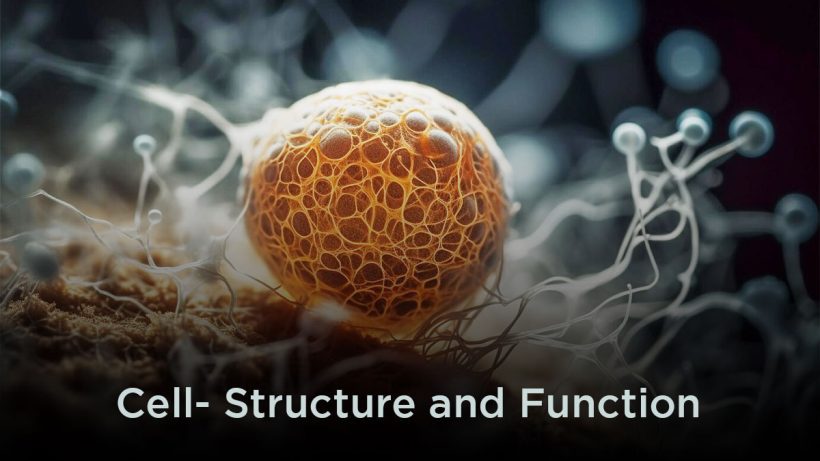Structure and Function of the Cell
Learn about “Cell – Structure and Function” in this comprehensive guide. Explore the roles of organelles, the cell membrane, and vital cell processes that sustain life. Understand how cells are the fundamental building blocks of all living organisms.
| Introduction |
| The Cell and Cell Theory |
| Difference between Plant cell and Animal Cell |
| Transport of Large Molecules (Bulk Transport) |
| Cell Wall |
| Nucleus the Hereditary Organelle |
| Molecules of the Cell |
Cells are the basic building blocks of all living organisms, playing a crucial role in biology. Understanding their structure and function is essential for grasping the complexities of life. This comprehensive guide delves into the details of cell structure and function, aimed at UPSC exam preparation students.
Cell Structure
Cells can be broadly categorized into prokaryotic and eukaryotic cells.
Prokaryotic Cells: These are simpler, smaller cells without a defined nucleus. Bacteria and archaea are typical examples. Their genetic material is located in the nucleoid, an irregularly-shaped region within the cell. Prokaryotic cells lack membrane-bound organelles, but they have essential structures such as:
- Cell Wall: Provides structural support and protection.
- Plasma Membrane: Regulates the movement of substances in and out of the cell.
- Ribosomes: Sites of protein synthesis.
- Flagella: Aid in cell movement.
Eukaryotic Cells: These cells are more complex and larger than prokaryotic cells, with a defined nucleus containing the cell’s genetic material. Eukaryotic cells are found in animals, plants, fungi, and protists. Key components include:
- Nucleus: Contains DNA and regulates gene expression.
- Mitochondria: Powerhouses of the cell, generating ATP through cellular respiration.
- Endoplasmic Reticulum (ER): Synthesizes proteins (Rough ER) and lipids (Smooth ER).
- Golgi Apparatus: Modifies, sorts, and packages proteins and lipids.
- Lysosomes: Contain enzymes for digestion of cellular waste.
- Peroxisomes: Break down fatty acids and detoxify harmful substances.
- Cytoskeleton: Provides structural support and facilitates cell movement.
- Chloroplasts (in plant cells): Sites of photosynthesis, converting solar energy into chemical energy.
Cell Function
The primary functions of cells revolve around maintaining homeostasis, energy production, growth, and reproduction.
- Homeostasis: Cells regulate their internal environment to maintain a stable, constant condition. The plasma membrane plays a crucial role in this by controlling the entry and exit of substances.
- Energy Production: Cells produce energy through cellular respiration in mitochondria. In plants, chloroplasts capture light energy and convert it into chemical energy through photosynthesis.
- Protein Synthesis: Ribosomes are the sites of protein synthesis, translating genetic instructions into functional proteins necessary for cell activities.
- Growth and Division: Cells grow and divide through processes like mitosis and meiosis. Mitosis results in two identical daughter cells, essential for growth and repair. Meiosis produces gametes with half the genetic material, crucial for sexual reproduction.
- Communication: Cells communicate with each other through chemical signals. Hormones and neurotransmitters bind to receptors on the cell surface, triggering specific responses.
- Transport: Cells transport materials internally and externally via passive (diffusion, osmosis) and active (pumps, endocytosis, exocytosis) mechanisms.
Cell Theory and Modern Understanding
The cell theory is a fundamental principle in biology, stating that all living organisms are composed of cells, and new cells arise from pre-existing cells. This theory, proposed by Schleiden, Schwann, and Virchow, laid the foundation for modern cell biology.
Advancements in microscopy and molecular biology have expanded our understanding of cell structure and function. Techniques like fluorescence microscopy, electron microscopy, and genetic engineering have revealed intricate details about cellular processes and their regulation.
Conclusion
Understanding cell structure and function is crucial for comprehending the complexities of life. Cells, with their diverse structures and functions, are the foundation of all biological processes.
This knowledge is indispensable for UPSC exam preparation, providing a solid base for topics in biology, health, and disease. As science progresses, our understanding of cells continues to deepen, unlocking new insights into the very essence of life.
For more updates, explore the Physics. Feel free to share your thoughts and comments.
If you’re passionate about building a successful blogging website, check out this helpful guide at Coding Tag – How to Start a Successful Blog. It offers practical steps and expert tips to kickstart your blogging journey!
